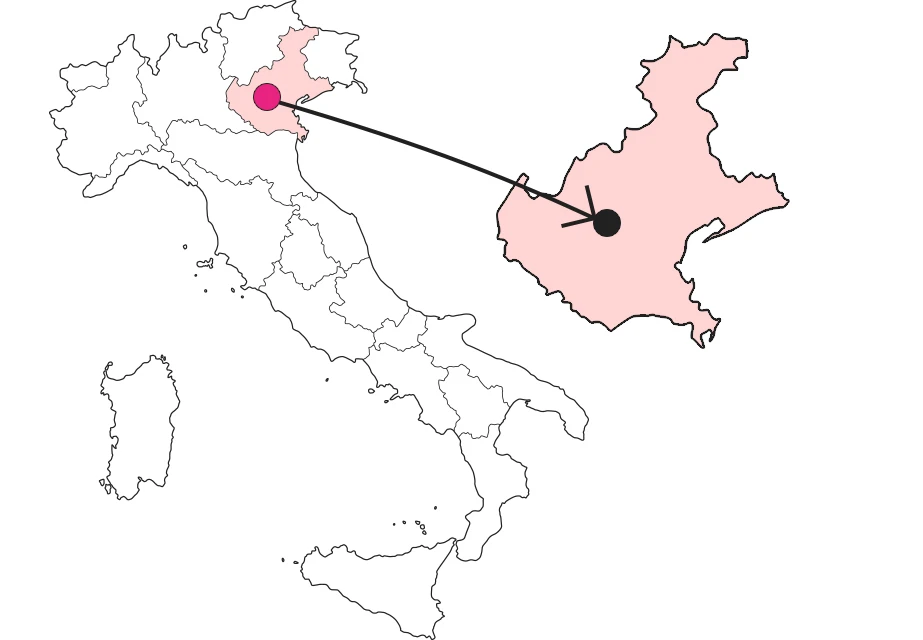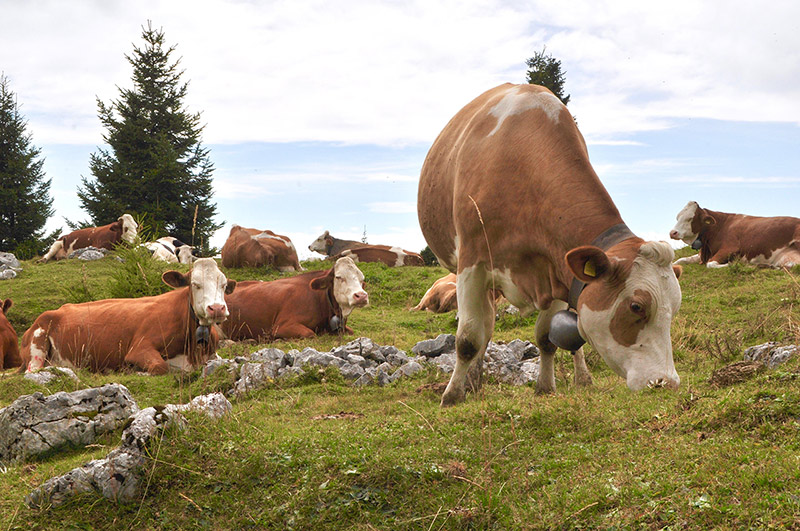













Malga Zebio
Cows and marmots there where the cannon thundered



Where

The malghe, the alpeggi and the plateau
The Asiago plateau is an environment of many firsts: spread over 560 square kilometers, - already this is remarkable - it has 87 "malghe" (shepherd's huts) around which the ancient economy of mountain pasture, documented here since the year 1000, revolves. A sort of material ritual, which is renewed every year with the ascent of herds and flocks to the high-altitude meadows, in the prospect of staying there until late summer, taking advantage of their summer exuberance to produce cheeses of incomparable flavor.
A malga is actually a production complex comprising various structures: the hut, where the titular family stays; the casara, used for milk processing and the first maturing of the cheeses; the stable for the dairy animals, mostly cows, and the pigsty for the complementary rearing of a few pigs for the purpose of salami making, read 'sopresse'. All around, the pastures, consisting partly of natural grasslands and partly of areas taken from the forest and then stubbornly defended from its return. Each pasture 'loads' more or less a hundred head of cattle, according to a calculation aimed at avoiding over-exploitation of natural resources. In essence, an eco-sustainable ante litteram activity with a balance between nature and human activity established over the centuries.
 Malga Zebio, ready to make cheese
Malga Zebio, ready to make cheeseThe trip, an opportunity to get a foretaste of the beauty of the plateau
The most common access road to the Plateau is the Cost Road. Sixteen hairpin bends, crossing the 1,000-meter threshold, beyond which an exciting expanse of grassy undulations punctuated by sharp Venetian-style bell towers opens up to view. In the background, the scenic ridge culminating in the 2341 meters of Cima Dodici, which from its name anticipates the wartime history of these places. Reaching Asiago, we continue to Val Giardini along a dirt road that within a few kilometers leaves the woods, also marked here by the infamous Vaia storm of 2018, and climbs toward the summit area of Monte Zebio (m 1717). The malga of the same name is at the edge of a short flat section of the road, which then continues up and down.
Arriving early in the day, one can watch the milking, which the cows diligently undergo before heading off on their own to their daily pasture. In the casara, the malghese first skims the milk and then heats it to the required temperature for the rennet to cause the separation of the solid component. The resulting mass, the curd, will then be portioned and distributed in the molds, while from the remaining liquid, cottage cheese will be made and from the cream, butter. A small dairy miracle, repeated every morning.
 The pezzate rosse of Malga Zebio
The pezzate rosse of Malga ZebioFrom bucolic industriousness to memories of the war, the step is short
From the malga it is a matter of five minutes to climb to the Crocetta di Zebio, a rocky prominence that offers a sweeping view of the plateau below. Close to its rounded summit remain the stone walls of what was a small military quarter during World War I. A few more steps and you understand why it was there: a maze of trenches literally dug into the rock, with ladders, gun emplacements, and underground shelters where you could find escape from the bombs. The work of the Austro-Hungarian army, it remained impregnable until the end of hostilities, despite multiple Italian attempts. All of it, perfectly legible, thanks to restoration work carried out as part of the Great War Ecomuseum in the Vicentine Pre-Alps. Among other things, the Crocetta di Zebio site has the distinction of being crossed by the Sentiero della Pace (Peace Trail), a 500-kilometer hiking route that connects salient sites of the conflict, from the Tonale Pass, in Lombardy, to the Marmolada, in Veneto.
 The trenches of the Crocetta di Zebio
The trenches of the Crocetta di ZebioA trip down memory lane
The day in the malga, with inescapable gastronomic implications, read polenta, cheese and sopressa, and then the tour of the Crocetta trenches, meditating on the fate of those who dug them, might even be enough to say one is satisfied with the day. It would really be worthwhile, however, to go a little further, continuing on the same road until reaching the Lunetta di Zebio, marked by a red marble stele. The area is sacred because under the scattering of rocks rest three hundred Italian infantrymen, victims of a catastrophic explosion in a wretched mine war, one trying to blow up the other and vice versa. Except that here it seems to have been a fatality, probably lightning, that caused the tragedy. Continuing on through pleasant scenery of meadows and forests, we finally reach one of the 41 military cemeteries that remain on the Plateau: that of the glorious Sassari Brigade, 212 crosses testifying to Sardinia's sad contribution to the Highland War. The whole, one hour round trip, again as part of the Great War Ecomuseum, with detailed explanatory tables.
Sassari Brigade
"The drama of war is the assault. Death is a normal occurrence and one dies without fright. But the consciousness of death, the certainty of inevitable death, makes the hours before it tragic.... The assault. Where would one go? One would abandon the shelters and go out. Where? The machine guns, all of them, lying on the belly stuffed with cartridges, were waiting. Those who did not know those moments, did not know war." So wrote Emilio Lussu, officer of the Sassari Brigade, in his book Un anno sull'Altipiano, recalling the vain sacrifice of the Italians on Mount Zebio; a masterpiece of anti-militarist literature, surely the read to carry under your arm while visiting the sites. It was, because of its central location, a pivotal stronghold on the Austrian line and for that reason equipped with a formidable system of trenches, tunnels and emplacements, challenging which, from June 1916 to July 1917, the Italians suffered very heavy losses. It was on this very stretch of the front line that the Sassari Brigade won one of its four gold medals to the flag, but without being right with the Austrian defense.
 Dotted gentian
Dotted gentianSurprise encounters in the meadows
One need only stand still for a while, running one's gaze across the grassy amphitheater rising behind the hut, to catch some hasty movement. A marmot! And then another! In short, a whole colony of these well-furred rodents, going about their daily business of putting on fat for the winter or huddling in skirmishes of hierarchy. And the same is true up at the Crocetta, where you can happen to look out from a trench and get a scare from the alarm whistle of the marmot manning it. In short, despite the wartime history and human activities, nature seems to be in full control of the place.
For the naturalist, it is a hoot, especially the flowers, in great variety, and the birds of the open spaces. The botanical peculiarity is the spectacular punctuated gentian (Gentiana punctata), typical of the Alps, but infrequent in the Vicenza area, with the exception of Mount Zebio itself, where it has found its habitat in certain depressions in the ground typical of the karst environment. As for birds: spioncelli, prispoloni, culbianchi... but you would need binoculars. Except in the case of the impertinent redstart (Phoenicurus ochruros), a representative of the flycatcher family, which is precisely why it loiters unceremoniously around the hut, passing from a protruding rock to the barn fence, swinging its tail continuously in an unmistakable manner.
Enter the Map of Italy's Undiscovered Wonders and find treasures where you least expect it... Inspire, Recommend, Share...
Collections

